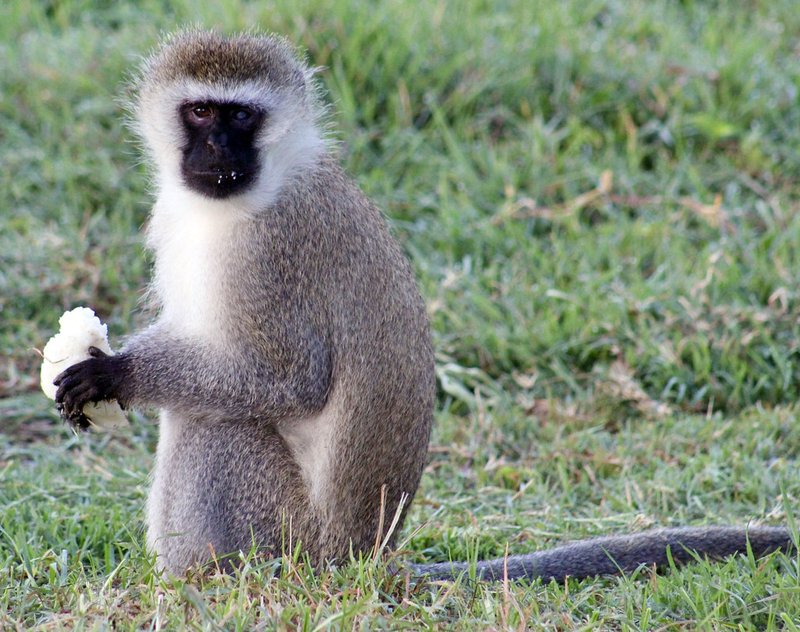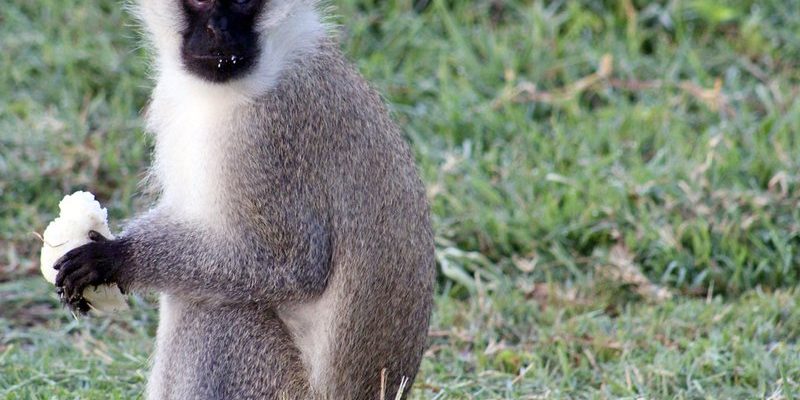
Imagine tracking the story of the vervet monkey like a captivating saga, unfolding across the vast landscapes of Africa. This journey begins long before modern humans roamed the Earth. Through this exploration, we’ll see how these monkeys adapted to their environment, evolved socially, and continue to thrive today. So grab your favorite drink, and let’s delve into the fascinating world of the vervet monkey’s evolutionary history!
What Are Vervet Monkeys?
Vervet monkeys, known scientifically as *Chlorocebus pygerythrus*, are medium-sized primates with striking features. They have a distinctive black face, bright blue scrotums, and greenish-gray fur, making them easily recognizable. Weighing around 10 to 15 pounds and standing about 18 to 24 inches tall, these monkeys are known for their agile movements and vocalizations.
These monkeys predominantly inhabit the savannas, grasslands, and forests of sub-Saharan Africa. Their social structure is quite telling; they live in troops that can range from 10 to over 50 individuals. This social dynamic plays a vital role in their survival, helping them forage for food, avoid predators, and raise their young collectively.
Their diet includes fruits, leaves, seeds, and insects, which they skillfully find in various environments. This varied diet helps them adapt to changing conditions and contributes to their evolutionary success.
The Evolutionary Lineage
The evolutionary history of the vervet monkey can be traced back to the *Old World monkeys*, which separated from the ancestors of the *New World monkeys* approximately 25–30 million years ago. Within the Old World monkeys, vervet monkeys belong to the *Cercopithecinae* subfamily, which includes other monkeys like baboons and macaques.
Here’s the thing: the divergence of vervet monkeys from their closest relatives showcases their adaptability to various habitats in Africa. Over time, they developed traits that allowed for better survival in open grasslands and forest edges, such as their superb climbing abilities and social interactions.
Diving deeper, it’s fascinating to note that the African climate has significantly influenced their evolution. As forests receded and grasslands expanded, vervet monkeys adapted to these new environments. Their dietary versatility and social structures became key factors in their success, enabling them to thrive in diverse habitats.
Social Structure and Behavior
Vervet monkeys exhibit a highly organized social structure, which is quite remarkable. They live in matrilineal groups led by dominant females. This social hierarchy is important for resource access, mating opportunities, and protection against predators.
Social interactions among vervet monkeys are complex and include grooming, which strengthens relationships within the troop. Grooming isn’t just about cleanliness; it’s a social bonding activity that helps reduce stress and foster cooperation. Honestly, watching them engage in this behavior can be a bit like observing a group of friends sharing secrets and laughter!
Additionally, vervet monkeys have a rich vocal communication system. They use different calls to alert their troop members of dangers like approaching predators. These calls vary based on the type of threat, providing insight into their ability to convey complex information—a sign of their advanced cognitive skills. You might be wondering why this matters. Well, effective communication enhances their chances of survival, allowing them to respond swiftly in life-threatening situations.
Adaptations to Their Environment
One of the most intriguing aspects of vervet monkeys is their adaptability. Over millions of years, these monkeys have developed various strategies to survive in the often-challenging environments of Africa. Their physical adaptations, such as strong limbs and a keen sense of sight, allow them to navigate through trees and grasslands with ease.
For instance, vervet monkeys have excellent vision, which helps them spot predators from a distance. This keen eyesight is paired with their agility, allowing them to escape danger quickly. Imagine them darting up a tree as a leopard prowls nearby—it’s a survival mechanism that has evolved over generations.
Moreover, vervet monkeys have learned to exploit their environment effectively. They often forage in varied habitats, showing remarkable flexibility in their diet. This ability to adapt to different food sources is crucial in times of scarcity when resources become limited.
The Role of Vervet Monkeys in Ecosystems
Vervet monkeys play a vital role in their ecosystems. As foragers, they contribute to seed dispersal, which aids in plant reproduction. When they eat fruits and seeds, they often travel long distances before excreting the seeds, effectively planting them in new locations. This behavior helps maintain the health of their habitat.
Additionally, vervet monkeys are part of the food web. They serve as prey for larger predators, such as leopards and eagles. Their population numbers directly influence other species, making them integral to maintaining ecological balance.
It’s also worth noting the relationship vervet monkeys have with other animals. Sometimes, they form alliances with birds, like oxpeckers, which help keep them free of parasites. This mutualistic relationship demonstrates how interconnected life is and why every species, including vervet monkeys, plays a part in the greater ecological picture.
Threats and Conservation Efforts
Despite their adaptability, vervet monkeys face several threats today. Habitat loss due to deforestation and urban expansion poses significant risks. As humans encroach on their habitats, vervet monkeys lose vital resources like food and shelter.
Additionally, poaching and hunting are concerns in some regions. Although vervet monkeys are not endangered, their populations can be affected by local hunting pressures. Conservation efforts are crucial to protecting their habitats and ensuring their survival.
Various organizations work to promote awareness about the importance of vervet monkeys in ecosystems. These efforts include habitat restoration projects and educating local communities on sustainable practices. It’s a collective responsibility to ensure these charming primates continue to thrive in their natural habitats.
The Future of Vervet Monkeys
Looking ahead, the future of vervet monkeys hinges on our actions today. As climate change impacts the environments in which they live, their adaptability will once again be tested. Understanding their evolutionary history helps us appreciate their resilience and the challenges they may face.
Conservation initiatives that focus on habitat preservation and sustainable practices are essential. By supporting organizations dedicated to protecting wildlife, we can play a part in ensuring that these remarkable monkeys continue to flourish for generations to come.
As we reflect on the evolutionary journey of vervet monkeys, it’s clear they are more than just playful creatures swinging from branches. They’re a testament to the power of adaptation and the intricate connections within ecosystems. By valuing and protecting them, we honor the rich history of these amazing primates.

